The development of the Birmingham over the last 300 years is intimately linked to the industrial revolution and the growth of UK engineering and manufacturing industries.
Birmingham’s rich industrial heritage makes it ideally placed to drive a new, green industrial revolution, based on a zero-carbon, clean-air energy system, infrastructure and economy. However, it faces significant challenges: Birmingham has one of the greatest rates of fuel poverty in the county and poor air quality across the city contributes to up to 900 premature deaths a year.
The City is developing ambitious plans for a just transition to net zero carbon emissions by 2030 in parallel with significantly improving air quality. The BEI is working in partnership with stakeholders across the city, exploring bold and coordinated approaches to tackling these issues and drive the change needed, providing academic leadership and support.
Tyseley Energy Park
Tyseley Energy Park (TEP), developed by Webster and Horsfall’s 300-year-old manufacturing business, is set to become the energy and waste nexus for the city of Birmingham, showing how novel energy technologies can form an innovative industrial ecology. It will help shape the way the City of Birmingham develops infrastructure for renewable heat and power, energy storage, clean transport fuels in combination with advanced waste processing.The West Midlands region faces severe energy, business and social challenges; energy poverty is the worst in the UK; there is a high concentration of intensive manufacturing; poor quality air and areas of electricity grid constraint. To work towards overcoming these challenges, the University of Birmingham has invested in to TEP.
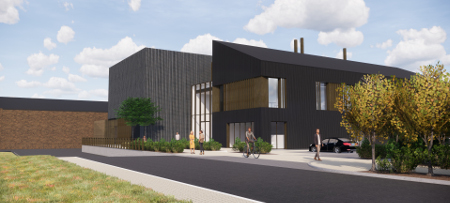 At TEP the University of Birmingham is building an innovation centre that will provide businesses with the chance to develop their technology in collaboration with university staff at the energy park. The Birmingham Energy Innovation Centre will be a hub for training associated with state-of-the-art energy, waste and low-carbon transport systems.
At TEP the University of Birmingham is building an innovation centre that will provide businesses with the chance to develop their technology in collaboration with university staff at the energy park. The Birmingham Energy Innovation Centre will be a hub for training associated with state-of-the-art energy, waste and low-carbon transport systems.
River Cole and Tyseley Energy Park: Creation of a Community Commons
The University of Birmingham are collaborating with Birmingham City Council, the Environment Agency, the Active Wellbeing Society, Sport England and other local partners to deliver the River Cole and Tyseley Energy Park - Creation of a Community Common project funded by the European Regional Development Fund (ERDF).
If you’d like to learn more about the project or want to speak about partnerships and collaboration with the project, then please email beirivercole@contacts.bham.ac.uk.

River Cole and Tyseley Energy Park: Creation of a Community Commons Project Completion (Video transcript)
River Cole and Tyseley Energy Park: Creation of a Community Commons Project - Weir Removal (Video transcript)
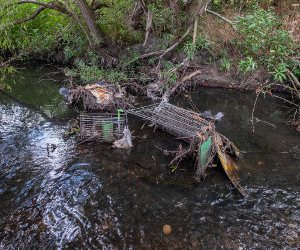
This partnership project will deliver a programme of blue and green infrastructure improvements across a 55-hectare site, owned by Birmingham City Council, that stretches along the river Cole from Heybarnes Recreation Ground via Tyseley Energy Park to Ackers Adventure.
Activities will enhance habitats and biodiversity, improve the sustainability, connectivity and accessibility of the area, and increase its value and benefit as a commons space for the local community. It will also rehabilitate a currently underutilised urban, green space as an integral part of a green, active travel corridor in East Birmingham.
The project will also help bring to life Birmingham City Council’s joint vision with University of Birmingham and Tyseley Energy Park to create a Green Innovation Quarter in the Tyseley Environmental Enterprise District. As part of a programme of research and innovation activity into net-zero pathways in East Birmingham, it will also help to ensure that communities and residents benefit in real-terms from the current investment in East Birmingham.
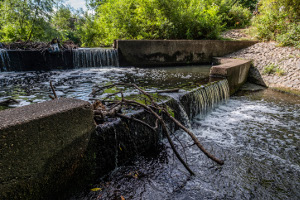
A series of interventions will improve the river and habitat connectivity for wildlife, manage bankside trees and woodland to improve visibility and remove invasive species to restore and enhance natural capital.
A flagship intervention, delivered by Sanctus Ltd, with match funding from the Environment Agency, is the removal of a 2.6 m concrete weir in the river Cole channel alongside Ackers Adventure - a man-made structure built over 150 years ago. The removal of this significant concrete barrier will create a more resilient environment with improved ecological status and will open-up a 14 km stretch of river, allowing the watercourse channel to re-naturalise and improve habitat connectivity for aquatic wildlife.
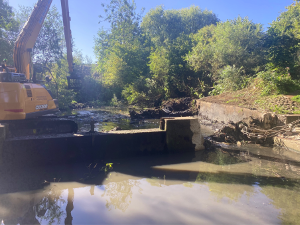
In addition to habitat improvements a series of community spaces will be created across the project area, including community gardens and meadows, food growing areas and outdoor classrooms. These will be connected by innovative lighting solutions powered by renewable energy, improved cycle paths, and signage and wayfinding installations such as planters and art-work, co designed with the local community.
A programme of community engagement, led by the Active Wellbeing Society working with Places in Common, will run alongside habitat improvements and common space creation. The aim of the engagement is to make sure the spaces are of use and benefit to residents and communities, and there is a sense of community ownership of the changes happening in the area. The project will also establish an innovative community-led body to oversee the long-term sustainable management and maintenance of the newly-created, community owned space.
River Cole Project Litter Picks
The River Cole project team are organising a Monthly Litter Pick starting on Thursday 20th October at 10am for UoB students, staff and local businesses and charities to help control the litter in the area. All equipment is provided and everyone is welcome to join.
Occuring the third Thursday of evenery month, each litter pick will begin at the Birmingham Energy Innovation Centre, Energy Way, Tyseley, B25 8FJ.
Please email beirivercole@contacts.bham.ac.uk to register to ensure that the team have enough equipment on the day.
Working with Industry
The BEI SME Engagement Programme, ATETA, helps organisations in the zero carbon energy technologies sector overcome their obstacles and unlock business opportunities. Since its launch in 2017, it has offered advice and support to more than 100 businesses within the Greater Birmingham and Solihull Local Enterprise Partnership.
ATETA provides FREE access to our team of Knowledge Exchange Fellow’s (KEFs) who will work with SMEs in our state-of-the-art research facilities and laboratories to identify ways for businesses to improve efficiency, identify new market prospects, test and demonstrate new ideas and ultimately grow their business. To date the programme has succeeded in generating a net income of almost £25 million for the local economy.
Working with Students
Researchers from the BEI are working with the Birmingham Energy Society to support their engagement activities and provide the Society with opportunities to get involved with our work at Tyseley Energy Park.
The BEI has also partnered with Tyselely Energy Park to support the development of energy engineering skills amongst the school children and local community of Tyseley and Hay Mills. The Energy Engineering Skills for the New Industrial Revolution project will raise awareness of Tyseley Energy Park and its role in the region's transition to a zero-carbon economy.
Our Policy Research
Researchers from the BEI, in partnership with Climate-KIC have completed a series of policy studies to identify scenarios and action to tackle some of Birmingham’s greatest challenges.
The identified scenarios and recommendations from each study will be developed to support the City in its bold ambition to reach net-zero carbon emissions by 2030.
Power to the People [PDF - 1.6MB], produced in partnership with Birmingham City Councillor, Lisa Trickett, and Kingscote, sets out three scenarios that can build upon the established assets and planned developments of the East Birmingham and North Solihull Inclusive Growth corridor.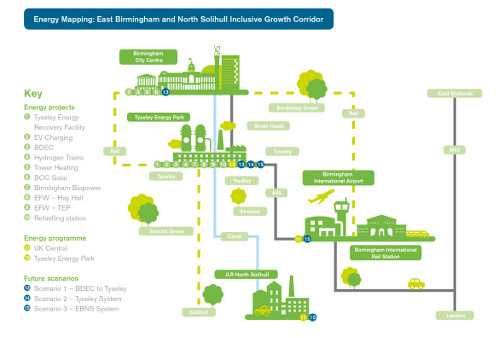
The recommendations within this report are to establish a co-ordinated, systematic approach to climate innovation in Birmingham, addressing issues such as fuel poverty, energy security, decarbonisation and air quality.
These identified scenarios include:
- Harnessing the waste heat from Tyseley Energy Park to feed the Birmingham District Energy Company heat network.
- Further harness waste heat to create a localised heat network for the area, creating the potential to take many thousands of homes off gas central heating to a waste heat-fed scheme
- Drive low carbon energy development along the Eastern corridor by creating a linkage between Tyseley and Solihull, paving the way for creating an entirely self-energised region – locally generating and utilising all the heat and power required by the corridor.
The ConnectedClusters [PDF - 5.6MB] project is at the start of an ambitious journey to discover how to unlock climate innovation whilst delivering renewal and clean growth in communities across Europe.
A ConnectedCluster offers a concentration of resources, expertise and initiatives that will help meet the Paris climate targets while also reaping social and economic benefits that come with the development and delivery of cleantech solutions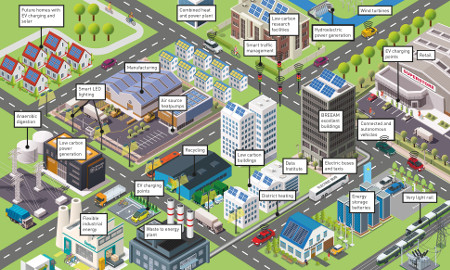
Our researchers and partners assessed five dynamic, city region-based climate innovation clusters where businesses, academics, communities and government work together to deliver low-carbon innovation.
This report explores:
- the challenges and opportunities involved in creating a climate innovation cluster
- how to create and share guidance and insights on how to make the conditions for a successful climate innovation cluster a reality, including successes and failures
- how to boost the capacity and effectiveness of the project partner clusters in their context
- generate an education programme that trains people based in EU city-regions to build and lead successful climate innovation clusters
- how to build a network of European climate innovation clusters and help them to collaborate and share insights and resources
- the co-development and sharing of a new concept of clusters/clustering innovation
- how to export the knowledge of climate innovation clusters across Europe so that others can make the shift and contribute to the Paris Agreement goals and subsequent UN climate meetings
The study gained a top-level insight into the dynamics of cluster growth, explored the narratives of each cluster and analysed their key developmental factors. This was followed by the identification of areas of commonality whilst differentiating areas specific to certain cluster types. The study offers a toolkit for other city regions, like Birmingham looking to set up Climate Innovation Clusters to drive climate innovation.
Tyseley Energy Park – Energy Strategy Report
Researchers from the BEI, Siemens and Tyseley Energy Park (TEP) mapped the existing and proposed energy supply and demand within TEP as well as the wider Tyseley Environmental Enterprise District (TEED). By mapping supply and demand in this way the report aimed to help to inform future energy strategies, policy direction and future investment decisions in relation to energy infrastructure.
Depending on the optimisation criteria, it was established that TEED and TEP could produce up to 515 GWh of electricity, 523 GWh of heat energy, or 63 GWh (1900 tonnes) of hydrogen per year. This study explores three different ways in which this energy could be used to support the City of Birmingham achieve their ambitious emission reduction targets.
The cases identified in this report will feed in the Birmingham Route to Zero task force and the recommendations will be shared with Birmingham City Council to explore the most suitable scenario for the City.
The three scenarios explored in this study are:
- Building a district heating line and private wire to new housing developments in Birmingham to supply ~50,000 people with all their electricity demand and 75% of their heating demand. The CO2 emissions savings could be up to 90 kt per year. The clean air targets are supported as no local combustion in the residential areas is required.
- Building a heat network and private wire to the airport to supply the entire demands for electricity, heating and cooling. Depending on the assumed baseline, this could lead to CO2 emissions reduction of ~10 kt per year. As TEP’s output potentials are even larger, the energy demands of additional customers in the airport area could be supplied with green energy.
- An annual local hydrogen production potential of 1.9 kt tonnes H2 (Electrolyser and Pyrolysis) may be used to supply up to 50 fuel cell buses and six trains in the wider Birmingham area, resulting in ~19kt of CO2 emissions reduction. Diesel imports could be substantially reduced and the local clean air targets in Birmingham would be supported. Even more trains could be supplied e.g. by installing additional electrolysers and leveraging the large amount of electricity production from TEED/TEP.
Hydrogen as a component of City Development
The Hydrogen as a component of City Development report [PDF - 7.4MB] estimates that green hydrogen can be competitive with diesel (for transport) at a utilisation factor of 50% and at an average cost per megawatt/hour of between £35 and £55 (dependent on electrolysis technology used).
The study found there are some strong cases for the acceleration of hydrogen-based infrastructure in cities and explored different ways to increase the amount of hydrogen being developed at Tyseley Energy Park.

As a zero carbon fuel and with the economics reaching a level that is competitive with the status quo, the study recommended that further research and development into the hydrogen production process is taken on. Waste to fuel shows significant potential as a source of hydrogen and working closely with the power market should enable lower cost hydrogen and thus more economic applications.
Further to this, the study concluded that Tyseley Energy Park could be viewed as an exemplar for future energy development. With a limited amount of land close to Birmingham City centre, much capability has already been delivered and is in the pipeline. Once fully operational, TEP has the potential to fuel up to 300 buses or 75 train carriages. With the total bus and train fleet of Birmingham being significantly more than this, further such energy parks would be required or a further intensification of hydrogen production at TEP would be required – the key to which would be the co-location of generation and conversion technologies and a co-ordinated cross-city approach to development.
Strength in Common: A Just Transition and Recovery in a Post-COVID World
The Birmingham Energy Institute has partnered with Places in Common to produce a report that explores how we can harness the assets of East Birmingham and connect communities to deliver the system change needed to drive net zero, economic resilience & recovery in a post-COVID world.
The approach ensures the communities in East Birmingham are at the forefront of a just transition to net-zero, prepared and supported to benefit from new employment training and economic opportunities and not left behind.
Strength in Common focuses on harnessing assets in four key areas though the establishment of Community Learning Platforms and a suite of Test and Learn projects:
- Housing retrofit, heat decarbonisation and improving neighbourhoods across the corridor
- A new economy that reconciles East Birmingham’s industrial past with a green future, regenerates the canal and supports SMEs and community enterprise
- The Green Way - an accessible and connected green corridor and green mobility hub
- New skills, employment and learning pathways that connect people of all ages to opportunities arising from the ne-zero transition and new economy
Strength in Common: A Just Transition and Recovery in a Post-COVID World (PDF 53MB)
Route to Zero Taskforce
The BEI represents University of Birmingham on the City’s Route to Zero (R20) Taskforce. The Task Force is developing an action plan showing how everyone in Birmingham can contribute to tackling climate change and the transition to net zero carbon, as well as benefit from a safer, fairer, healthier and more sustainable city. It brings together Members and officers from the Council alongside representatives from the West Midlands Combined Authority, the NHS, higher education, business, faith communities, the third sector, unions, young climate strikers, climate campaigners, and other key partners and stakeholders.
The BEI is also part of the Task Force Communications and Engagement subgroup and is supporting the engagement with stakeholders across the city through a number of sandpits and workshops.